The historical portrait is a great way to understand our legacy. Don’t consign it to the back room.
One of my favorite museums is the National Portrait Gallery (NPG) in London. That’s not because its collection is stellar—it’s piddling compared to the nearby National Gallery. It tells the story of Britain through art, and I love history.
There’s so much you can learn from portraits—the manners and mores of the times, the sitters’ blind spots and where they had to be flattered. Portraits, particularly painted ones, are romantic in a way that photographs are not. And then there’s simple curiosity. What did Thomas Cranmer, Admiral Nelson or Florence Nightingale really look like?
Among the paintings on display when I visited the NPG were the portraits of Iroquois chieftains—Joseph Brant, Red Jacket, Cornplanter and Governor Blacksnake. The Iroquois Confederacy played important roles in both the Revolution and the French and Indian War, as full allies of the British. Joseph Brant was once important enough to have been painted by court painter George Romney in London and Gilbert Stuart here.
The NPG is suffering from falling visitation, dropping from 1,703,411 in 2017 to 1,586,451 visitors in 2018. As bad as that sounds, it understates the problem. Visits are down more than 25% from the 2.1 million visitors they recorded in 2015/16. Then, management blamed the drop on a counting error by an external company.
Now critics suggest that the current decline may be due to director Nicholas Cullinan’s pursuit of diversity. “If the implication of this criticism is that we and other museums should not programme contemporary artists (which in our case happen to be mostly women) and only feature well-known names, I think we have a problem with metrics that focus on quantity alone.”
That’s a bit of a red herring. Britons have a long and sometimes mystifying affection for contemporary art. In fact, Tate Modern is the UK’s biggest visitor attraction.
 |
|
The Slave Gang, c. 1900, by unknown artist, glass magic lantern plate, published by The London Missionary Society, courtesy National Portrait Gallery.
|
Still, it’s hard to imagine that people come to the NPG for the contemporary portraits. They come to see the Chandos William Shakespeare, exquisite Elizabethan miniatures, or ponder the sad story of Lady Jane Grey. The NPG’s charm lies in its antique fustiness. It’s the thinking tourist’s Tower of London experience.
The portrait gallery can only be as diverse as the society it represents, which in much of Britain’s history meant white people painted by men. Today British society is more plural, but it’s also glutted with imagery. Nobody needs to go to the NPG to see what the Prime Minister look like—her photo is everywhere. Nobody needs to go there to look at the British Everyman, either, since he’s just down the street.
Emphasizing diversity can be a way of saying, “Look how backwards our ancestors were.” England was, from the 16th century to the 20th, an empire. Empires are by nature diverse. Those Iroquois leaders in a museum dedicated to British subjects were one example. So are 31 different maharajas represented in more than 200 portraits. Or the two great empire-building British rulers, Elizabeth I and Victoria, and the longest-reigning British monarch, Elizabeth II. There’s plenty of diversity in British history once you stop pigeonholing what diversity means.








